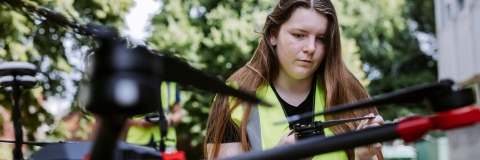
On your course you might encounter working with different types of equipment, having to travel, or lifting heavy items. Here's what you need to know to stay safe.
Specific safety guidance
There are regulations in place to make sure you don't hurt yourself while moving or lifting heavy equipment.
All staff and students who engage in manual handling and lifting heavy items must undertake suitable and sufficient training to ensure they do so safely.
The University has equipment to help you with moving large or heavy equipment, including trolleys and sack trucks. You can request these via the Health & Safety team on hsservicedesk@port.ac.uk.
There are regulations in place to make sure you are safe when working anywhere where a fall could cause injury.
All staff and students who plan to work at height must undertake suitable and sufficient training to ensure they do so safely. Any such work should be properly planned and supervised.
You should only use ladders where it's safe to do so, using three points of contact, and for as short periods of time as possible. There are also requirements in place for safety measures such as working platforms, guard rails and fall protection systems.
You find out more on the Government's HSE website or can request more information via the Health & Safety team on hsservicedesk@port.ac.uk.
Drones are an expanding area of interest in many areas of the University. Drones are, however, potentially dangerous and there are clear data protection issues around drone data collection. Drones in the UK are regulated by the Civil Aviation Authority and data collection is regulated by the General Data Protection Regulation (“GDPR”) and the Data Protection Act 2018.The University strictly adheres to applicable laws, including guidelines published by the CAA.
Read our Student Drone Arrangement
What you need to do
The University has a duty of care to make sure that you are acting legally and safely when flying in connection with your studies. You can only fly or use drones if:
1) You have a relevant risk assessment (RA) approved by a competent member of staff. This is in addition to the normal departmental/school RA process for projects. You can email drone@port.ac.uk to find a suitable trained member of staff.
2) You must submit a declaration form with the RA.
3) You must provide an Operator ID and Flyer ID from the Drone and Model Aircraft Registration and Education Scheme.
4) You must label any drone or model aircraft they are responsible for with the Operator ID.
5) You must demonstrate to the competent member of staff that you are competent in flying drones by providing one of the below:
- BMFA A Certificate or higher for the class of drone being used.
- CAA certificate of competence for the class of drone being used.
- Other relevant qualification for the drone being used.
- Self-certification of appropriate experience of the drone being used. Provide a statement or documentation.
6) You must at all times comply with applicable law and be aware of the Government's Drone Code.
7) You must declare that you have appropriate insurance.
8) You must declare that you have permission from the land owner for take-off and landing.
9) You accept all liability arising from your use of drones.
10) You should follow the best practices outlined in the University Operations Manual (OM) for drones. This is for guidance only - you are not covered by the UoP OM.
11) If there are any ethical issues, these must be considered and an application be made to the Departmental/Faculty Ethics Committee if appropriate, e.g. to comply with the law collection of images of identifiable individuals may be subject to data protection legislation.
Other guidance
We strongly recommend joining a local model flying club to learn to fly and practice your skills. Clubs provide training and will have a safe area to fly in. To find a local club consult the BMFA website.
We monitor the use of weapons on University premises for theatrical, artistic and research purposes.
Weapons of any kind are not normally permitted on University owned or controlled property. However, there are certain circumstances where they may be required (e.g. theatre production, filming or for research purposes). Under these circumstances the following procedures should be followed in order to ensure the safety of all involved (including third parties) and in order to comply with the law.
Anyone participating in work involving firearms must comply with the legal requirements under The Firearms Act 1968; in particular Regulation 19 concerning carrying a firearm in a public place:
A person commits an offence if, without lawful authority or reasonable excuse (the proof whereof lies on him) he has with him in a public place:
- a loaded shot gun,
- an air weapon (whether loaded or not),
- any other firearm (whether loaded or not) together with ammunition suitable for use in that firearm, or
- an imitation firearm
It is permissible under Regulation 12 of the Firearms Act for a person to have a firearm in their possession for the purpose of a film or theatre production (including rehearsal).
What you need to do
You must fill out a Weapons and Firearms Form and include all the information required. This is to ensure relevant stakeholders can be made aware of any sanctioned activity.
Anyone with concerns regarding a project proposal that appears to be illegal or of a suspicious nature should contact Campus Security on extension 3333 immediately.
Further guidance to assist in completing risk assessments within CCI is available from the websites listed below:
- Health and Safety Executive (HSE) for advice on the risk assessment process and requirements
- Filming and photography in and around Portsmouth, contact Portsmouth City Council (PCC) for a license to film or a photography shoot
- Royal Institute of British Architects (RIBA) for advice on health and safety for architects
- Association of British Theatre Technicians (ABTT) offers technical resources for theatre technicians
- The Arts Council offer advice, guidance and toolkits on various aspects of the arts
- British Broadcasting Corporation (BBC) offers guidance and advice on photography safety and journalism
- The Health and Safety Executive give advice and guidance on fashion and textiles, including dyes and dyeing
- The BBC offers guidance and advice on filming and productions which is set out in a series of safety guides
Completing a risk assessment
A risk assessment is a careful examination of what in your activities could cause harm to people, so that you can weigh up whether you have taken enough precautions or should do more to prevent harm.
In many instances, it's easy to reduce risks - for example ensuring spillages are cleaned up promptly so people do not slip, or that cupboard drawers are kept closed to ensure people do not trip. UK law does not expect you to eliminate all risk, but you are required to protect people as far as reasonably practicable.
This is not the only way to do a risk assessment; there are other methods that work well, particularly for more complex risks and circumstances. However, we believe this method is the most straightforward for the University.
Everyone involved in a project or event should read and understand the risk assessment, before the event takes place.
Useful documents
- Risk Assessment Form - a blank form to either print off and complete manually, or download and complete electronically. You should keep copies in either or both formats, but you must be able to provide them if asked to do so.
- Risk Assessment Guidance - to assist you in completing the risk assessment form
- Risk Assessment Tool - to help you identify hazards and measures to reduce the risk
- Acknowledgement of Risk Assessment Form - confirmation that all relevant people have read and understood the risk assessments
Reporting accidents and incidents
An accident is an unplanned event that results in injury or ill health. An incident may be a near miss or undesired circumstance that has the potential to cause injury, ill health, damage or loss.
All accident and incidents, however minor, should be recorded and reported to Health Safety and Compliance.
If you need to report something, please use this form.
Contact the University's Health and Safety Team
If you're not sure about what steps you need to take to keep yourself safe, or would like some advice, you can contact the Health & Safety team on hsservicedesk@port.ac.uk.






